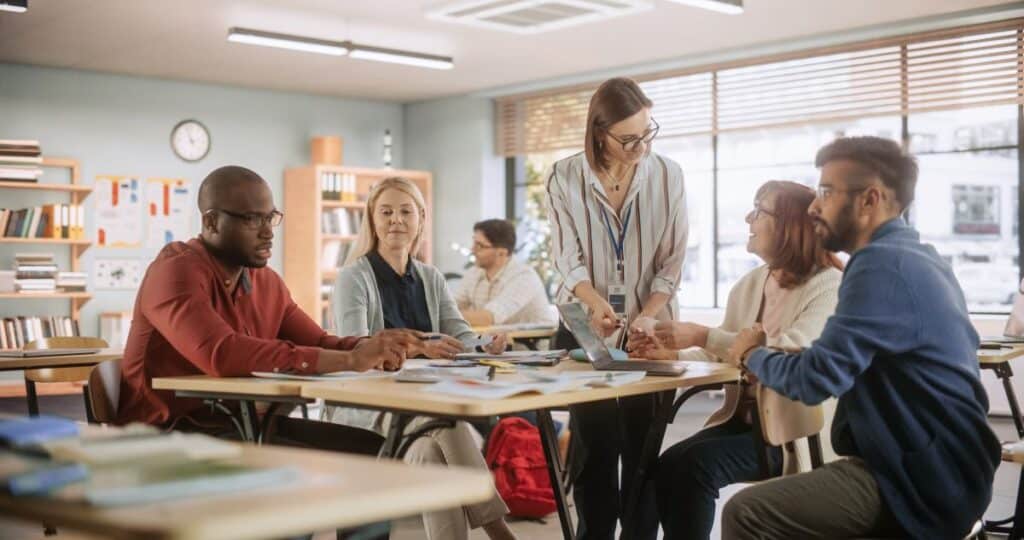In education, the goal is to enhance the learning experience of students. Whether it is the K-12 arena or higher education increasing the ability of students to learn is important. Teachers and administrators continue to look for new and innovative ways to optimize students’ learning experiences and the communities they are a part of. One way this is done is by establishing Professional Learning Communities (PLC’s). There are other names synonymous with PLC’s such as community learning communities or professional learning groups. However, the goal is still the same: increasing and enhancing student learning.
Along with teacher collaboration and the influence of school administrators, teaching and learning has seen various changes since the COVID-19 pandemic. This allows for continued innovation and a diverse range of methods to teach students. The traditional direct instruction method is still used; however, with most school districts and colleges going to either hybrid models or full online instruction, it is important to understand how PLCs can enhance students’ ability to learn.
Additionally, these PLC’s help teachers, professors, and school administrators find new techniques to engage students. In order to understand the impact of PLC’s on learning it is important to understand what PLC’s are and the benefits and impact they bring.
Core Principles and Definitions
According to the web-based information system PowerSchool, a professional learning community (PLC) is a team of educators who meet consistently to share ideas that broaden their teaching skill sets and facilitate whole-child learning. The core principles for PLCs are to have members be collaborative and data-driven and create space for innovative ideas.
For K-12 teachers, PLC’s can be formed by grade levels or departments. Traditionally under the influence of building leaders and instructional coordinators in K-12, these PLC’s serve as a platform to brainstorm ideas that are most beneficial for student learning.
Furthermore, PLC’s should be student-focused, action oriented, and always geared towards continuous improvement. In higher education the same is true as well. While in K-12 schools, teachers and administrators may focus on unpacking the curriculum standards or finding ways to promote higher-order thinking with their students, professors and higher education administrators may be focused on how to enhance the use of Learning Management Systems or how to help first generation and undergraduate students understand their various coursework.
Benefits and Impact
The benefits and impact of PLC’s are very influential when done with fidelity. Creating a culture of collaboration gives teachers the autonomy to lead and learn within their professional development sessions. Having a diverse range of thinkers helps when working together in the PLC meetings. There are effective ways to make professional learning communities run smoothly.
It is important to note that effective PLC’s are action research-based. This includes the members looking at lesson plans and student achievement data, discussing the data trends that are seen, and finding ways to implement student growth. Professional learning communities that use academic research, literature, and current best practices see results in student learning and the skills of teachers.
All of these aspects together make a significant impact on the teaching and learning process for the school. By collaborating and then creating and implementing the most effective strategies for learning this creates a win-win for everyone. This is seen through the role of leadership and support within the PLC. As participants continue to work together the work done in PLC’s benefits all.
The Role of Leadership and Support
The role of leadership and support within PLC’s is vital. Participants need to feel free to learn and to share ideas. School administrators and department heads can take the lead initially to set group norms and protocols of the meetings. Once this is done, there needs to be an emphasis on all members’ accountability to contribute to the learning process. These meetings should be held at the discretion and guidance of what the norms and protocols are for the sessions.
Meetings can be once a week, bi-weekly, or once a month. Regardless of the established meeting times, consistent purposeful discussions and strategic planning in the meetings must be consistent. As members support each other, the skills and techniques learned, such as data analysis, implementing rigor in lessons, and best practices in classroom management, will contribute to the success of student learning.
Future of PLC’s
Professional Learning Communities play a significant role in 21st-century teaching methods. With the emphasis on Learning Management Systems, effective student engagement, and 21st-century learning skills PLC’s have a bright future. Today’s PLC’s include a wide range of professional development, including literacy development for struggling readers, strategies for incorporating educational technology in the classroom, leadership development for teachers and administrators, and much more.
As students worldwide continue to be more connected through technology, social media platforms, and further communication, educators must stay relevant with new trends and the most effective ways to support student learning.
Educators never stop learning; check out our available graduate degree programs to hone your skills and promote lifelong learning and academic excellence.




